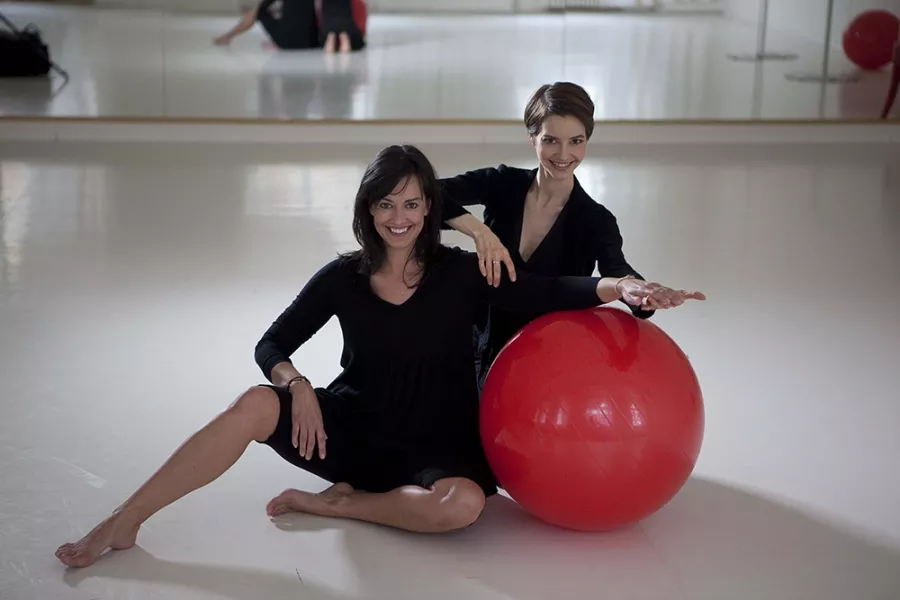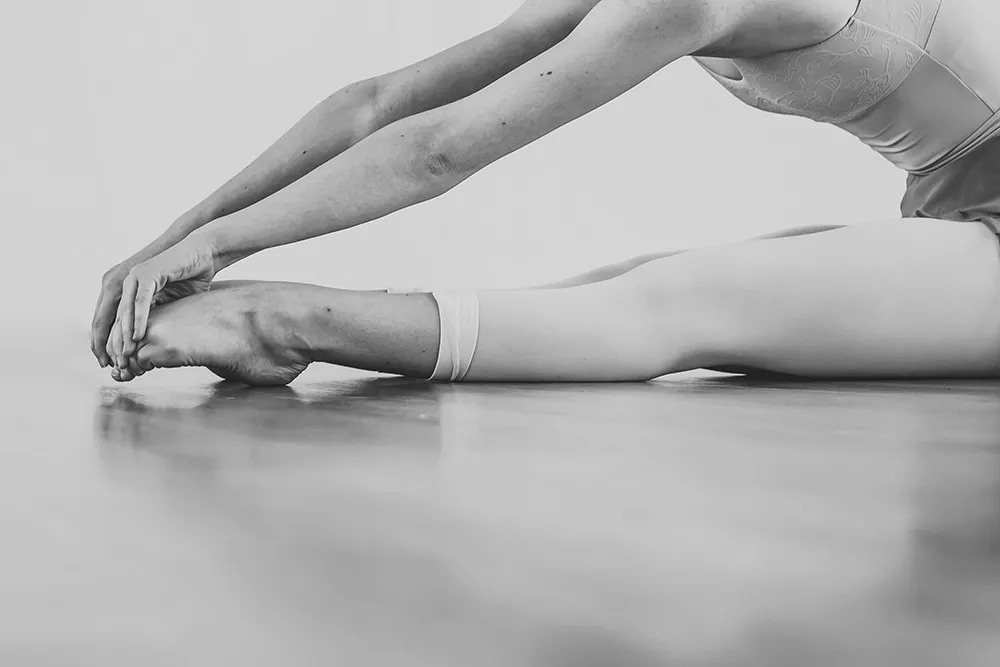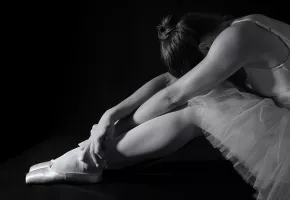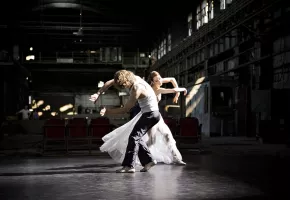Dance Medicine and the Yotai Method
Klára Lidová is the founder of the Yotai method, which focuses on compensation and regeneration of ligaments and muscles of dancers. In this interview, she describes her journey to studying this field as well as the benefits and risks of working with fascial massage tools.

Fasciae are elastic fibers that are found in the ligaments and sheaths of muscles. They have a major influence on our mobility and healthy body position. Through fascial research, Klára Lidová seeks to find new methods to keep dancers, athletes and other people with high physical demands healthy.
Read about how she got to her methods through addressing issues with her own body marked by her professional dance career and learn how to properly use the now widely used fascial massagers.
- Beginnings of the journey
- International experience
- Scientific community
- Yotai
- Loss of ligament elasticity
- Fascial roller
- Risks
- Proper use
- Pain
- Safe stretching
What was your journey into the study of musculoskeletal and therapeutic methods?
For me, the journey has primarily led through my own body.
I started dancing at the age of 4. I got into a lot of exercise when the structures weren't ready for it. I'm genetically hypermobile.
A normal person has a system of, as I put it in layman's terms, safety belts in the car, and that's our ligament. Really strong ligament bands that hold our body together and prevent the joint from getting dislocated. The ligaments contain collagen and elastin fibers. I have a lack of collagen, which is firm, and a lot of elastin, which is incredibly flexible.
So I can put my leg, my arm, anywhere, up to very dangerous ranges.
The National Theatre took me on at the age of 4 because they saw me and thought I would be brilliant material. So they started to use that material more and more and develop the hypermobility even further. As a result, from the age of 15 I was forced to start thinking about what to do with my body through a series of dislocations, joint wear and injuries.
International experience
In the beginning of the 90s I was very lucky to get to Vienna, and then to France.
Fascial research as such takes 2007 as its starting point. But in Austria and France, on some intuitive and semi-scientific level, dancers around the Paris Opera had been working with fascia since the 70s.
Soloists from the Paris Opera connected with anatomists and rehabilitation doctors and began to ask themselves analytically if things could be done differently so that they wouldn't end up in a wheelchair at age 33.
I was incredibly fortunate to meet progressive teachers, and to travel abroad to places with a different trend and a different approach to the dancer's body.
Scientific community
Because I got into fasciae through foreign experience right from the start, my path just naturally continues to flow.
Soon I got into the fascial community here in the Czech Republic. I have also already managed to establish myself in the fascial scientific community connected to the latest research.
Interestingly, within that fascial community, everyone originally came from some sort of movement background. One fellow scientist was an Italian figure skating champion for 10 years, another one used to do martial arts. They all started studying fascia through feeling the fascia first, perceiving it. They found out what repetitive injuries their body was going through. They wanted to help themselves.
The fascial research was driven by self-help.
I knew in my heart that this was my path.
I became such a maniac. For me, there's basically no evening when I would watch a movie or read fiction. If I'm going to watch something in the evening, I'm going to listen to lectures by my sports medicine colleagues. We spend two hours together every night discussing client cases.
It's my obsession, my passion.
Yotai
Yotai is a movement system that focuses on the interplay of the nervous system, fascia and muscles, leading to stabilization and control of the body and healthy development of movement.
When I do my Yotai method, I often get visited even by doctors. There's a doctor, the head of a department, she has 15 physiotherapists in her team. But for some reason, when she wants to get her body in shape, she comes to me. She doesn't primarily go to her physiotherapists because, as she told me:
"They have knowledge from books and lectures, but I'm not at all inspired by their body. What they apply to me, they haven't mastered themselves. They're moving in a learned structure, but you always say something that's beyond that structure."
Not having a box imprinted in my head, I am able to see a solution that a doctor who has been in the system for 30 years just sometimes doesn't see.
It's quite possibly my advantage, but it also brings a huge lack of confidence in myself. I'm always observing and checking myself. I don't trust my judgment.
I try to network and consult every client with at least five experienced colleagues. Everyone brings their point of view and then I believe there is a way to help that particular client together.
Loss of ligament elasticity
In addition to ligaments, the fascial tissues include all muscle sheaths.
Every muscle, every muscle bundle, every muscle spindle, and even every muscle fiber has a collagen-elastin sheath. It's like a grapefruit, which is covered with a white membrane when peeled. Then we break the grapefruit down into pieces, and each piece also has its own membrane. Even the individual grains in each piece are covered with a micro membrane. It's the same with the muscles.
The membrane has an incredible ability to transmit and spread information throughout the body. At the same time, it can gently contract and relax.
Fascial tissue also has the ability to contract based on our emotional attunement.
When I feel bad, I slouch - collapse my chest, put my shoulders up and forward a little, lock my neck. All of this is caused by the muscles, but most importantly the fascia initially contracts.
When a body works well, the different muscle groups and fascia slide over each other in a fluid environment.
We can think of it like a cashmere sweater. When we take good care of it, it's smooth and elastic. But if we accidentally wash it at high temperature, it gets baked, wrinkled and loses its elasticity. The same thing happens to the ligaments.
Fascial roller - therapeutic help or hell?
Some of you may be familiar with this rehabilitation tool. A massage roller designed to relax the musculoskeletal system. Is it really that beneficial?
The rollers have a very good idea and are indeed based on fascial research.
The nice idea behind fascial props like fascial balls, fascial rollers, vibration rollers, is how to make that baked ligament and the muscle sheaths nice and supple again, sort of fluid and slippery.
But you need to know exactly where in the body you want the fascial tissue to be more elastic, but where you really need it to maintain its firmness, where you really need that collagen.
Risks
I've done incredible damage to my body with the roller. And I meet more and more people who have done exactly the same thing to themselves, because the roller is a huge hit right now.
I, as a hypermobile person, have had a lifelong problem around my sacrum and lumbar region. Any movement I should create with my shoulder or leg, I create primarily in that hypermobile area. But if I had a beautiful tight fascia there, it just wouldn't allow me to move into incorrect positions.
And because I was also excited many years ago when I saw my first roller at a convention, I immediately bought one. I was one of the first people in the country to have a fascial roller. Every time I had a free moment, I rolled. I rolled everywhere, and where I was most comfortable was the lumbar spine.
This created total armageddon for me over the course of two years, because the already relatively under-functioning stabilizing fascia in my lumbar region, which should be about 5mm thick, was completely thinned by the rolling. It's currently (I measure it every month by ultrasound, I do a sort of annual survey on myself) 0.7mm. Which is a total disaster, because my back is totally unprotected.
It will take at least a few more years before I can hopefully get my ligaments stronger again.
Proper use
The roller should be indicated as a rehabilitation method in medical offices.
The roller is a great thing if I know I want to stimulate a muscle for five or ten seconds before exercise. It'll just connect the brain to the muscle and warm it up.
Then the roller is good if I want to really loosen up a particular fascia. To make a firm ligament elastic again. By loosening the fascia, the muscle that's in spasm can relax. So the roller works perfectly as a relaxation aid for the fascia and therefore the muscle.
But only if I know which muscle I can afford to relax and which one I need to hold my body together. In any case, I think the roller should stay in rehabilitation centers and doctor's offices, it shouldn't come into anyone’s home at all. Home "self-therapy" with a roller can cause really extreme problems. I know what I'm talking about, I've hurt myself really brutally.
Don't fall for every new thing that appears. When working with the musculoskeletal system you need expertise in what changes are desirable.
Pain is always a warning sign
Pain is primarily a warning signal; pain is not meant to be a pleasant signal.
As dancers for accompanying program, we have often been taught that pain is a part of training. I have developed a certain addiction to it. We feel good about developing and improving through pain.
Especially with ligaments though, pain can mean I'm getting the joint into a lot of trouble. Into positions where it's not protected, and where it shouldn't properly be. This will inevitably show up later. I still need to be aware of what's happening to me and if I'm going through the pain.
Safe stretching
The best way to stretch safely is to stretch only where I can actively pull the limb myself, by muscles.
There's no point in sitting for 10 min in an ecarté, in a "pancake", and completely pulling the ligament if I can only pull the leg up to 150 degrees on my own when I stand up. Whenever I have more range in the ligament than my muscle control of the joint, that joint gets into trouble.
The joint is only at its optimum where the muscles keep it properly centered. The moment when I pull the ligament but have no muscular control at all in that range, I'm on incredibly thin ice, and somewhere along the line a huge problem will occur. The injury comes. And if not injury, then by repetitive stretching outside the safe zone for the joint, wear = arthrosis will come.
So it's always best to figure out where I can pull that leg or arm only by muscles. Then stretch 5 to 10 degrees more and repeat that position until I have muscle strengthening there again. Only then can I allow myself to stretch more again.
So always proceed with
CAUTION,
and be conscious all the time.
Be aware of your body and take good care of it.
Source: http://yotai.cz/
About the author

Tereza Adamusová
She has been on the artistic scene since 2010. She has taught juggling and performed with the group T.E.T.R.I.S. As a performer, she has been in several major productions and has performed in hundreds of shows around the world. Since childhood, she has been doing gymnastics and acrobatic synchronized swimming. As a dancer and actress she has performed in Czech musicals. She co-owns the Aliatrix agency and as creative director, she is also the main producer of all major projects.








